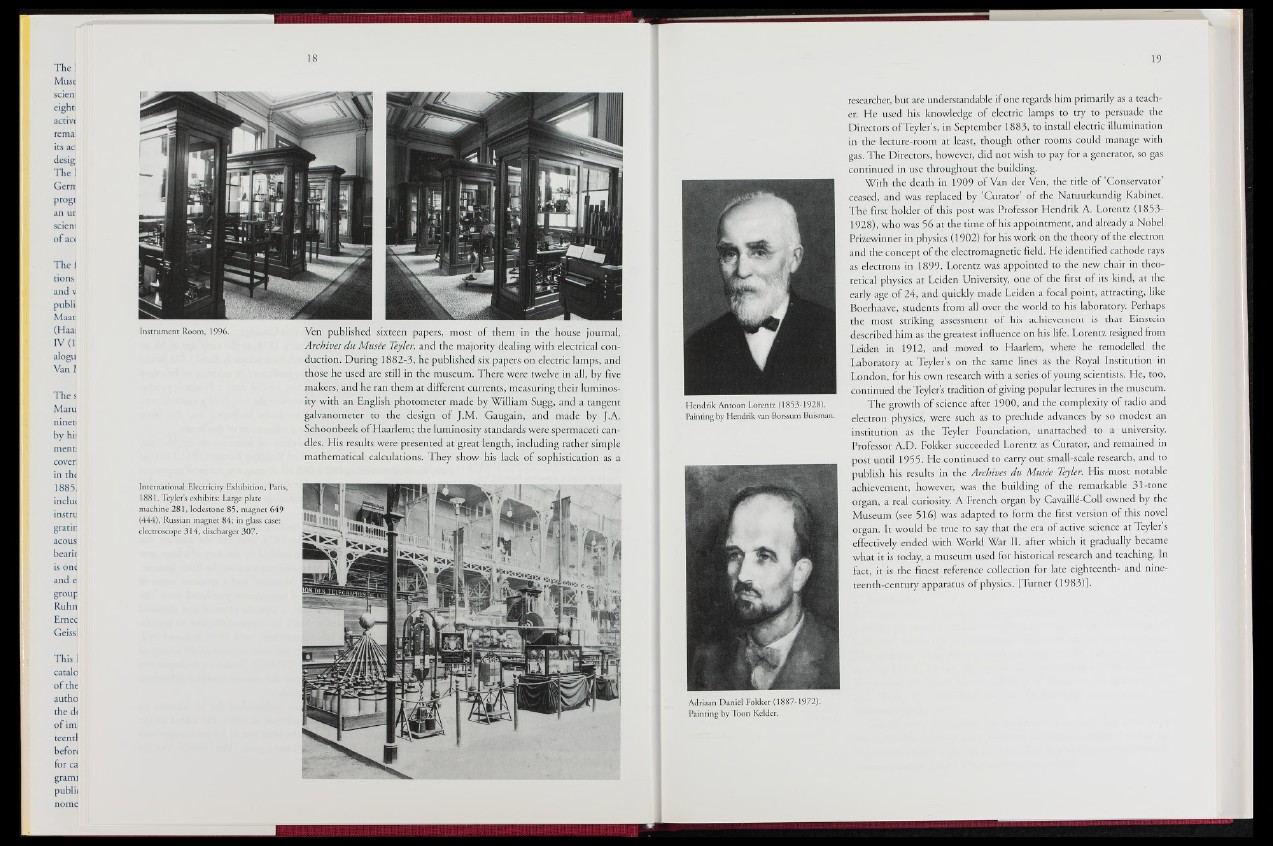
The ]
Musc
sciern
eight
active
remai
its ac
desig
The]
Gem
progt
an ur
scieni
of ac<
The!
tions
and v
publi
Maac
(Haai
IV (1
alogu
Vanì
Thes
Maru
nineti
by hi.'
mene
cover,
in the
1885.
inclue
instru
gratin
acous
bearii
is one
and e
group
Ruhn
Emec
Geissl
This)
catalo
of the
autho
the d<
of imi
teentl
before
for ca
grami
publie
nome
Instrument Room, 1996. Ven published sixteen papers, most of them in the house journal,
Archives du Musée Teyler, and the majority dealing with electrical conduction.
During 1882-3, he published six papers on electric lamps, and
those he used are still in the museum. There were twelve in all, by five
makers, and he ran them at different currents, measuring their luminosity
with an English photometer made by William Sugg, and a tangent
galvanometer to the design of J.M. Gaugain, and made by J.A.
Schoonbeek of Haarlem; the luminosity standards were spermaceti candles.
His results were presented at great length, including rather simple
mathematical calculations. They show his lack of sophistication as a
International Electricity Exhibition, Paris,
1881. Teyler’s exhibits: Large plate
machine 281, lodestone 85, magnet 649
(444), Russian magnet 84; in glass case:
electroscope 314, discharger 307.
Hendrik Antoon Lorentz (1853-1928).
Painting by Hendrik van Borssum Buisman.
Adriaan Daniel Fokker (1887-1972).
Painting by Toon Kelder.
researcher, but are understandable if one regards him primarily as a teacher.
He used his knowledge of electric lamps to try to persuade the
Directors of Teyler's, in September 1883, to install electric illumination
in the lecture-room at least, though other rooms could manage with
gas. The Directors, however, did not wish to pay for a generator, so gas
continued in use throughout the building.
With the death in 1909 of Van der Ven, the title of 'Conservator'
ceased, and was replaced by 'Curator' of the Natuurkundig Kabinet.
The first holder of this post was Professor Hendrik A. Lorentz (1853-
1928), who was 56 at the time of his appointment, and already a Nobel
Prizewinner in physics (1902) for his work on the theory of the electron
and the concept of the electromagnetic field. He identified cathode rays
as electrons in 1899. Lorentz was appointed to the new chair in theoretical
physics at Leiden University, one of the first of its kind, at the
early age of 24, and quickly made Leiden a focal point, attracting, like
Boerhaave, students from all over the world to his laboratory. Perhaps
the most striking assessment of his achievement is that Einstein
described him as the greatest influence on his life. Lorentz resigned from
Leiden in 1912, and moved to Haarlem, where he remodelled the
Laboratory at Teyler's on the same lines as the Royal Institution in
London, for his own research with a series of young scientists. He, too,
continued the Teyler’s tradition of giving popular lectures in the museum.
The growth of science after 1900, and the complexity of radio and
electron physics', were such as to preclude advances by so modest an
institution as the Teyler Foundation, unattached to a university.
Professor A.D. Fokker succeeded Lorentz as Curator, and remained in
post until 1955. He continued to carry out small-scale research, and to
publish his results in the Archives du Musée Teyler. His most notable
achievement, however, was the building of the remarkable 31-tone
organ, a real curiosity. A French organ by Cavaillé-Coll owned by the
Museum (see 516) was adapted to form the first version of this novel
organ. It would be true to say that the era of active science at Teyler's
effectively ended with World War II, after which it gradually became
what it is today, a museum used for historical research and teaching. In
fact, it is the finest reference collection for late eighteenth- and nineteenth
century apparatus of physics. [Turner (1983)].